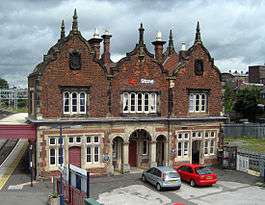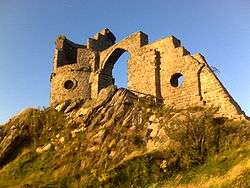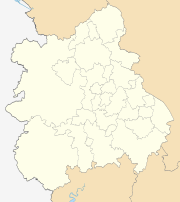Staffordshire
| Staffordshire | |||||
|---|---|---|---|---|---|
| County | |||||
| |||||
| Motto: "The knot unites" | |||||
 Staffordshire in England | |||||
| Coordinates: 52°50′N 2°00′W / 52.833°N 2.000°WCoordinates: 52°50′N 2°00′W / 52.833°N 2.000°W | |||||
| Sovereign state | United Kingdom | ||||
| Country | England | ||||
| Region | West Midlands | ||||
| Established | Ancient | ||||
| Ceremonial county | |||||
| Lord Lieutenant | Ian Dudson | ||||
| High Sheriff | Susie Lillingston | ||||
| Area | 2,713 km2 (1,047 sq mi) | ||||
| • Ranked | 18th of 48 | ||||
| Population (mid-2014 est.) | 1,098,300 | ||||
| • Ranked | 15th of 48 | ||||
| Density | 405/km2 (1,050/sq mi) | ||||
| Ethnicity |
97.0% White 1.7% S.Asian 1.3% Other | ||||
| Non-metropolitan county | |||||
| County council | Staffordshire County Council | ||||
| Executive | Conservative | ||||
| Admin HQ | Stafford | ||||
| Area | 2,620 km2 (1,010 sq mi) | ||||
| • Ranked | 18th of 27 | ||||
| Population | 849,600 | ||||
| • Ranked | 8th of 27 | ||||
| Density | 324/km2 (840/sq mi) | ||||
| ISO 3166-2 | GB-STS | ||||
| ONS code | 41 | ||||
| GSS code | E10000028 | ||||
| NUTS | UKG24 | ||||
| Website |
www | ||||
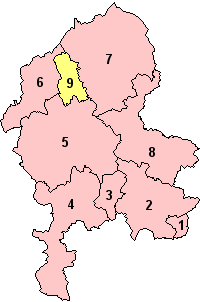 Districts of Staffordshire Unitary County council area | |||||
| Districts | |||||
| Members of Parliament | List of MPs | ||||
| Police | Staffordshire Police | ||||
| Time zone | GMT (UTC) | ||||
| • Summer (DST) | BST (UTC+1) | ||||
Staffordshire (/ˈstæfədʃɪər/ or /ˈstæfədʃə/;[1] abbreviated Staffs) is a landlocked county in the West Midlands of England. It adjoins Cheshire to the north west, Derbyshire and Leicestershire to the east, Warwickshire to the south east, West Midlands and Worcestershire to the south, and Shropshire to the west.
The largest city in Staffordshire is Stoke-on-Trent, which is administered separately from the rest of the county as an independent unitary authority. Lichfield also has city status, although this is a considerably smaller cathedral city. Major towns include Stafford (the county town), Burton upon Trent, Cannock, Newcastle-under-Lyme, Leek, and Tamworth. Smaller towns include Stone, Uttoxeter, and Rugeley, and large villages Eccleshall, Wombourne, Kinver, Penkridge, Tutbury and Stretton. Cannock Chase AONB is within the county as well as parts of the National Forest and the Peak District national park.
Wolverhampton, Walsall, West Bromwich, and Smethwick were historic Staffordshire towns until local government reorganisation created the West Midlands county in 1974.
Apart from Stoke-on-Trent, Staffordshire is divided into the districts of Cannock Chase, East Staffordshire, Lichfield, Newcastle-under-Lyme, South Staffordshire, Stafford, Staffordshire Moorlands, and Tamworth.
History
Historically, Staffordshire was divided into the five hundreds of Cuttlestone, Offlow, Pirehill, Seisdon, and Totmonslow.
The historic boundaries of Staffordshire cover much of what is now the metropolitan county of West Midlands. An administrative county of Staffordshire was set up in 1889 under the Local Government Act 1888 covering the county except the county boroughs of Wolverhampton, Walsall, and West Bromwich in the south (the area known as the Black Country), and Hanley in the north. The Act also saw the towns of Tamworth (partly in Warwickshire) and Burton upon Trent (partly in Derbyshire) united entirely in Staffordshire.
In 1553 Queen Mary made Lichfield a county separate from the rest of Staffordshire. It remained so until 1888.
Handsworth and Perry Barr became part of the county borough of Birmingham in the early 20th century, and thus associated with Warwickshire. Burton, in the east of the county, became a county borough in 1901, and was followed by Smethwick, another town in the Black Country in 1907. In 1910 the six towns of the Staffordshire Potteries, including Hanley, became the single county borough of Stoke-on-Trent.

A significant boundary change occurred in 1926 when the east of Sedgley was transferred to Worcestershire to allow the construction of the new Priory Estate on land purchased by Dudley County Borough council.[2]
A major reorganisation in the Black Country in 1966, under the recommendation of the Local Government Commission for England led to the creation of an area of contiguous county boroughs. The County Borough of Warley was formed by the merger of the county borough of Smethwick and municipal borough of Rowley Regis with the Worcestershire borough of Oldbury: the resulting county borough was associated with Worcestershire. Meanwhile, the county borough of Dudley, historically a detached part of Worcestershire, expanded and became associated with Staffordshire instead. This reorganisation led to the administrative county of Staffordshire having a thin protrusion passing between the county boroughs (to the east) and Shropshire, to the west, to form a short border with Worcestershire.
Under the Local Government Act 1972, on 1 April 1974 the county boroughs of the Black Country and the Aldridge-Brownhills Urban District of Staffordshire became, along with Birmingham, Solihull, and Coventry and other districts, a new metropolitan county of West Midlands. County boroughs were abolished, with Stoke becoming a non-metropolitan district in Staffordshire, and Burton forming an unparished area in the district of East Staffordshire. On 1 April 1997, under a recommendation of the Banham Commission, Stoke-on-Trent became a unitary authority independent of Staffordshire once more.
In July 2009 the largest hoard of Anglo-Saxon gold ever found in Britain was discovered in a field near Lichfield. The artefacts, known as The Staffordshire Hoard have tentatively been dated to the 7th or 8th centuries, placing the origin of the items in the time of the Kingdom of Mercia.
Economy

This is a chart of trend of regional gross value added of the non-metropolitan county of Staffordshire at current basic prices published (pp. 240–253) by Office for National Statistics with figures in millions of British Pounds Sterling.
| Year | Regional Gross Value Added[3] | Agriculture[4] | Industry[5] | Services[6] |
|---|---|---|---|---|
| 1995 | 6,447 | 209 | 2,349 | 3,889 |
| 2000 | 8,621 | 150 | 2,986 | 5,485 |
| 2003 | 10,169 | 169 | 3,164 | 6,835 |
Some nationally and internationally known companies have their base in Staffordshire.They include the Britannia Building Society which is based in Leek. JCB is based in Rocester near Uttoxeter and bet365 based in Stoke-on-Trent. The theme park Alton Towers is in the Staffordshire Moorlands and several of the world's largest pottery manufacturers are based in Stoke-on-Trent.
Education
Staffordshire has a completely comprehensive system with eight independent schools. Most secondary schools are from 11–16 or 18, but two in Staffordshire Moorlands and South Staffordshire are from 13–18. Resources are shared where appropriate.
There are two universities in the county, Keele University in Newcastle-under-Lyme and Staffordshire University, which has campuses in Stoke-on-Trent, Stafford, Lichfield and Shrewsbury.[7]
Sport
The modern county of Staffordshire currently has three professional football clubs – Stoke City and Port Vale, both from Stoke-on-Trent, and Burton Albion, who play in Burton upon Trent.
Stoke City, one of the oldest professional football clubs in existence, were founded in 1863 and played at the Victoria Ground for 119 years from 1878 until their relocation to the Britannia Stadium in 1997. They were among the 12 founder members of the Football League in 1888.[8] By the late 1930s, they were established First Division members and boasted arguably the finest footballer in England at the time in right-winger Stanley Matthews, who had two spells with the club between 1930 and his retirement in 1965 at the age of 50.[9] In 1972, the club finally won a major trophy when they lifted the Football League Cup,[10] but after relegation from the First Division in 1985 they would not experience top flight football for 23 years.[11] After spending some two decades bouncing between the second and third tiers of the English league, they finally reclaimed their top flight status in 2008 by securing promotion to the FA Premier League – where they have remained ever since.[12] Stoke City reached their first FA Cup final in 2011, but lost to Manchester City.[13]
Port Vale, who like Stoke City play in Stoke-on-Trent, were formed in 1876 and became members of the Football League in 1892. After more than 70 years at various stadiums around the city, the club moved to its present home, Vale Park, in 1950. In early 1936, they had eliminated First Division champions Sunderland from the FA Cup. Another FA Cup success came in February 1988 when they eliminated seven-time winners Tottenham Hotspur from the competition. Promotion to the Second Division for the first time since the 1960s was secured in 1989, and Vale would spend nine of the next 11 years at this level. However, the club has been less successful since the turn of the 21st century, and suffered relegation to League Two – the fourth tier of the English league – in 2008. The club has seen an upturn in its fortunes as the club was promoted from league two in the 2012-13 season and currently holds a place in Football League One.[14]
West Bromwich Albion, Wolverhampton Wanderers and Walsall are also notable teams from the county, from the years when those locations were inside Staffordshire.
The county's other professional Football team is Burton Albion from Burton Upon Trent who currently play in the Football League Championship after back to back promotions in 2014–15 from League Two and 2015–16 from League One, after securing promotion to the Football League from the Conference for the first time in the 2008–09 season.
The county has a number of non-league football clubs, including Tamworth,[15] Stafford Rangers,[16] Hednesford Town[17] and Leek Town.[18]
In cricket, Staffordshire is one of the nineteen Minor counties of English and Welsh cricket. It is represented in Minor counties cricket by Staffordshire County Cricket Club who have played in the Minor Counties Championship since 1895, a competition which it has won outright eleven times, making it the most successful Minor counties team. Famous international cricketers produced by the county include Sydney Barnes, Bob Taylor and Dominic Cork, all of whom went on to represent England.
Geography
See the List of reservoirs in Staffordshire
In the north and in the south, the county is hilly, with wild moorlands[19] and uplands of the Peak District in the far north,[20] and Cannock Chase an area of natural beauty in the south. In the middle regions, the landscape is low and undulating. Throughout the entire county there are vast and important coalfields. In the southern part, there are also rich iron ore deposits. The largest river is the Trent. The soil is chiefly clay and agriculture was not highly developed until the mechanisation of farms.
Staffordshire is home to the highest village in Britain, Flash. The village, in the Staffordshire Moorlands, stands at 463 m (1518 ft) above sea level. This record was confirmed in 2007 by the Ordnance Survey after Wanlockhead in Scotland also claimed the record. The BBC's The One Show investigated the case in a bid to settle the argument and Flash was confirmed as the highest. The highest point in Staffordshire is Cheeks Point[21]
Demographics
According to the 2001 Census the population of the Non-metropolitan Staffordshire is 806,744 and the population of Stoke-on-Trent was 240,636 making a total population of 1,047,380. In non-metropolitan Staffordshire, White British is the largest ethnicity, making up 96% of the population. This is followed by White Irish, making up 0.6%. Non-White citizens make up 2% of the population.[22] 94% of the population was born in England, and those born in Scotland and Wales together make up 1% of the total population.[23]
Government
Staffordshire County Council is the top-tier local council for the non-metropolitan county. For Eurostat purposes, it is a NUTS 3 region (code UKG22).
Staffordshire operates a cabinet-style council. There are 62 councillors for Staffordshire. The Full Council elects a cabinet of 10 councillors, including the council leader, from the majority party. Each cabinet member has their own portfolio about which they make the "day to day" decisions.[24][25]
Latest Council Election results
| Staffordshire County Council election, 2013 | ||||||||||
|---|---|---|---|---|---|---|---|---|---|---|
| Party | Seats | Gains | Losses | Net gain/loss | Seats % | Votes % | Votes | +/− | ||
| Conservative | 34 | 34% | ||||||||
| Independent | 2 | 4% | ||||||||
| UKIP | 2 | 24% | ||||||||
| Labour | 24 | 30% | ||||||||
Boundary changes
Towns and villages
See the list of places in Staffordshire, list of Staffordshire settlements by population and the List of civil parishes in Staffordshire
Historic Towns/Cities
Some settlements which were historically part of the county now fall under the county of West Midlands (county):
| West Midlands | Aldridge, Bilston, Bloxwich, Brierley Hill, Brownhills, Coseley, Darlaston, Dudley, Kingswinford, Rowley Regis, Sedgley, Smethwick, Tipton, Walsall, Wednesbury, Wednesfield, West Bromwich, Willenhall, Wolverhampton |
|---|---|
Dogs
A type of bull terrier called the Staffordshire Bull Terrier was bred for hunting purposes in this county. They are known affectionately as "staffs", "staffies", and "nanny-dogs". Staffies should not be confused with the considerably larger American Staffordshire Terrier, American Pit Bull Terrier, and (English) Bull Terrier.
Religion
Church of England
The only Cathedral in the county is Lichfield Cathedral in the city of Lichfield. The Diocese of Lichfield covers the whole county with the exception of Stapenhill and Amington, and much of the nearby county of Shropshire and the Black Country area of the West Midlands. The county is covered by the archdeaconries of Stoke-on-Trent and Lichfield. The current Bishop of Lichfield is Jonathan Gledhill and the current Bishop of Stafford Geoff Annas. There are 298 Church of England Churches in the County.
Roman Catholic Church
Staffordshire is part of the Roman Catholic Archdiocese of Birmingham. The current Archbishop is Bernard Longley.
Methodism
Primitive Methodism was founded in Staffordshire by Hugh Bourne, a native of Stoke-on-Trent, at a public gathering in the village of Mow Cop. He originally followed the Wesleyan form of Methodism but in 1801 he reformed the Methodist service by conducting it outside. By 1811 with his brother he founded the first chapel in the Tunstall area of Stoke-on-Trent.[26]
Judaism
The most popular Synagogue in the county is on London Road in Newcastle-Under-Lyme which opened in 2006 and replaced the former "Birch Terrace" Synagogue in Hanley[27] according to the 2001 census there were 407 Jewish People in the non-metropolitan area of Staffordshire,[28] and 83 in Stoke-on-Trent,[29]
Islam
There are 15 mosques in Stoke-on-Trent, 5 in Burton-upon-Trent and 1 in both Stafford and Lichfield.[30] A new mosque[31][32][33] is under construction in the Hanley area of Stoke-on-Trent and will be the first purpose built mosque in the area. At the 2001 census there were 7,658 Muslims in Stoke-on-Trent and 6,081 in the rest of Staffordshire, with a total of 13,739 making up 1.3% of the population. 62.9% (3823) of the Muslims in the rest of Staffordshire are from the town of Burton-upon-Trent.[34][35][36][37][38][39][40][41]
Transport
Canals
Staffordshire has an extensive network of canals including the Birmingham and Fazeley Canal, Caldon Canal, Coventry Canal, Shropshire Union Canal, Staffordshire and Worcestershire Canal and Trent and Mersey Canal.
Railways
See Rail transport in Staffordshire
The county is traversed primarily by the West Coast Main Line.
Roads
The county has relatively good links to the national roads network. Several major roads intersect the county, making it a popular location for commuters working in Birmingham.
The M42 has a junction in Tamworth at the south-east of the county, and heads south-west towards Birmingham. The M6 runs north through the county and junctions 10A-16 are in the county. The M6 Toll, the UK's first toll motorway, runs through the county with junctions in Weeford near Lichfield, Cannock and joins the M6 heading north towards Stafford.
The A5 and A34 run through the county. The former has been significantly widened to a dual carriageway at several sections, although much of it remains single carriageway.
Air
There are currently no airports with scheduled flights in the county with the nearest ones being Birmingham, East Midlands and Manchester depending on the location there is however Wolverhampton Airport in Bobbington and Tatenhill Airfield near Burton-upon-Trent both of which are small airports catering for General Aviation.
Media

Newspapers
Daily Newspapers in Staffordshire are The Sentinel covering Stoke-on-Trent, Newcastle-under-Lyme and the Staffordshire Moorlands, Burton Mail which covers the town of Burton-upon-Trent and the Express & Star which has several editions covering Tamworth, Lichfield, Cannock Chase and Stafford.
Radio
The local BBC radio stations covering Staffordshire are BBC Radio Stoke covering Mid and North Staffordshire, BBC WM covering the south of the county and BBC Radio Derby covering East Staffordshire. The local commercial radio stations are Signal 1 and Signal 2 which cover North and Mid Staffordshire, and Touch FM, which covers Burton, Lichfield and Tamworth. Further stations which cover parts of Staffordshire include Heart, Smooth, and Planet Rock which cover the southern parts of the county. Free Radio Birmingham covers Lichfield and Tamworth, and Free Radio Black Country covers the Cannock area.
Community Radio
Staffordshire is served by a number of community radio stations. In North Staffordshire, there are five community radio stations – Moorlands Radio in Leek, 6 Towns Radio, based in Burslem, Cre8 FM, based at Staffordshire University, The Hitmix, based in Newcastle-under-Lyme and Cross Rhythms City Radio based in Hanley
In Stafford there are three community radio stations – Windmill Broadcasting, the UK's only radio station based in a Windmill, in the Broad Eye Windmill, Stafford FM, which broadcasts to the town on 107.3 FM, and BFBS, which will start broadcasting to MoD Stafford on FM in the near future.
In Cannock, there is Cannock Radio, which broadcasts online, and in Tamworth, there is TCR fm, which broadcasts locally on 106.8 FM.
Television
Staffordshire is predominantly covered by the ITV Central and BBC West Midlands television regions both of which have their studios in Birmingham. The far north of the county, around Biddulph, is served by ITV Granada and BBC North West from Media City UK in Salford.
Places of interest
| Key | |
| | Abbey/Priory/Cathedral |
| | Accessible open space |
| | Amusement/Theme Park |
| | Castle |
| | Country Park |
| | English Heritage |
| | Forestry Commission |
| | Heritage railway |
| | Historic House |
| | Museum (free/not free) |
| | National Trust |
| | Theatre |
| | Zoo |
- Alton Towers

- Ancient High House


- Belvide Reservoir
- Biddulph Grange

- Blithbury Reindeer Lodge
- Blithfield Hall
- Blithfield Reservoir
- Brindley Water Mill
.png)
- Broad Eye Windmill
- Burslem Hall

- Cannock Chase

- Chasewater Railway

- Cheddleton Flint Mill

- Churnet Valley Railway

- Croxden Abbey


- Dovecliff Hall
- Downs Banks

- Drayton Manor Theme Park

- Eccleshall Castle

- Festival Park

- Ford Green Hall

- Foxfield Steam Railway

- Gladstone Pottery Museum

- Hanley Park

- Heart of England Way
- Moseley Railway Trust (Apedale)



- Ilam Park

- Izaak Walton Cottage Museum

- Manifold Way following the route of the former Leek and Manifold Valley Light Railway
- National Brewery Centre
- Lichfield Cathedral

- Lichfield Road
- Madeley Old Hall

- Monkey Forest
- Moseley Old Hall

- Mow Cop Castle

- National Memorial Arboretum
- Peak District National Park
- RSPB Coombes Valley
- Rudyard Lake Steam Railway

- Sandon Hall
- Shugborough Estate

- Stafford Castle

- Staffordshire Regiment Museum
.png)
- Staffordshire Way
- Staffordshire Moorlands
- The Potteries Museum & Art Gallery
- The Pennine Way
- The Roaches
- Tamworth Castle

- Trentham Gardens
- Trentham Lakes
- Tutbury Castle

- Victoria Park

- Wall Roman Site


- Wedgwood Museum
.png)
- Weston Park

- Whitmore Hall

- Apedale Community Country Park



Gallery
-
.jpg)
Map of Staffordshire and its hundreds by Wenceslas Hollar some time between 1627–1677.
-

Boscobel House.
-
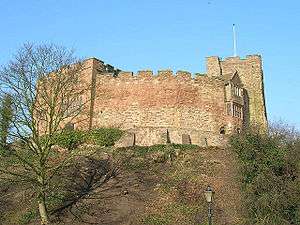
Tamworth Castle.
-

Lichfield Cathedral.
-

Weston Park
-

Wightwick Manor
-

The Staffordshire & Worcestershire Canal.
See also
- Lord Lieutenant of Staffordshire
- High Sheriff of Staffordshire
- List of MPs for Staffordshire
- Samuel Hieronymus Grimm
- The Stafford knot
- Tamworth Pig
- Healthcare in Staffordshire
- Staffordshire Police
- Staffordshire Police and Crime Commissioner
References
- ↑ "Staffordshire". Collins Dictionary. n.d. Retrieved 23 September 2014.
- ↑ "A History of Dudley". Localhistories.org. Retrieved 4 June 2012.
- ↑ Components may not sum to totals due to rounding
- ↑ includes hunting and forestry
- ↑ includes energy and construction
- ↑ includes financial intermediation services indirectly measured
- ↑ Staffordshire University Website. Staffs.ac.uk. Retrieved 25 August 2011.
- ↑ Stoke City | History | 1863–1888 in the Beginning. Stokecityfc.com. Retrieved 25 August 2011.
- ↑ Stoke City | History | 1930–1939 Stan's The Man. Stokecityfc.com. Retrieved 25 August 2011.
- ↑ Stoke City | History | 1970–1979 Waddo Believe It (Part Two). Stokecityfc.com. Retrieved 25 August 2011.
- ↑ Stoke City | History | 1980–1989 Five Managers, Five Chairmen. Stokecityfc.com. Retrieved 25 August 2011.
- ↑ Stoke City | History | 2000–2009 The Decade of Success. Stokecityfc.com. Retrieved 25 August 2011.
- ↑ Archive. TheFA.com. Retrieved 25 August 2011.
- ↑ Club | History | A Brief Club History. Port Vale. Retrieved 25 August 2011.
- ↑ Tamworth F.C. Tamworth FC. Retrieved 24 September 2014.
- ↑ Stafford Rangers FC. Stafford Rangers FC. Retrieved 25 August 2011.
- ↑ Hednesford Town FC – Hednesford Town Football Club Latest News. Hednesfordfc.co.uk. Retrieved 25 August 2011.
- ↑ Wilson, Ed. (21 August 2011) Leek Town – a Charter Standard club. Pitchero.com. Retrieved 25 August 2011.
- ↑ Staffordshire's 1,000-Foot Peaks, Kent, Jeff, Witan Books, 2013, ISBN 978-0-9927505-0-3.
- ↑ Enjoy Staffordshire. Accessed 7th December 2015.
- ↑ Staffordshire's 1,000-Foot Peaks, Kent, Jeff, Witan Books, 2013, ISBN 978-0-9927505-0-3.
- ↑ "Ethnicity in Staffordshire". ONS. Retrieved 22 April 2012.
- ↑ "Country of Birth Staffordshire". ONS. Retrieved 22 April 2012.
- ↑ "Role of County Council". Staffordshire County Council. Retrieved 5 May 2010.
- ↑ "Role of the Cabinet". Staffordshire County Council. Retrieved 5 May 2010.
- ↑ Sailsman, Zoe (2002). "Bringing in the sheep – Hugh Bourne, the religious reformer from Stoke". BBC Stoke & Staffordshire. British Broadcasting Corporation. Retrieved 20 May 2007.
- ↑ "BBC News-Birch Terrace synagogue deconsecration ceremony". BBC. Retrieved 4 June 2012.
- ↑ Neighbourhood Statistics. "Religion in Staffordshire". Neighbourhood.statistics.gov.uk. Retrieved 4 June 2012.
- ↑ Neighbourhood Statistics. "Religion in Stoke-on-Trent". Neighbourhood.statistics.gov.uk. Retrieved 4 June 2012.
- ↑ "Mosques in the United Kingdom". Mosques.muslimsinbritain.org. Retrieved 4 June 2012.
- ↑ Muslim, British (30 January 2009). "Mosque community centre plan unveiled". Thisisstaffordshire.co.uk. Retrieved 4 June 2012.
- ↑ "Four arrests over Stoke-on-Trent mosque arson". BBC. 3 December 2010. Retrieved 4 June 2012.
- ↑ "Stolen pipe used in Stoke-on-Trent mosque arson". BBC. 23 December 2010. Retrieved 4 June 2012.
- ↑ Neighbourhood Statistics. "Horninglow Religion". Neighbourhood.statistics.gov.uk. Retrieved 4 June 2012.
- ↑ Neighbourhood Statistics. "Eton Park Religion". Neighbourhood.statistics.gov.uk. Retrieved 4 June 2012.
- ↑ Neighbourhood Statistics. "Burton Religion". Neighbourhood.statistics.gov.uk. Retrieved 4 June 2012.
- ↑ Neighbourhood Statistics. "Winshill Religion". Neighbourhood.statistics.gov.uk. Retrieved 4 June 2012.
- ↑ Neighbourhood Statistics. "Brizlincote Religion". Neighbourhood.statistics.gov.uk. Retrieved 4 June 2012.
- ↑ Neighbourhood Statistics. "Stapenhill Religion". Neighbourhood.statistics.gov.uk. Retrieved 4 June 2012.
- ↑ Neighbourhood Statistics. "Anglesey Religion". Neighbourhood.statistics.gov.uk. Retrieved 4 June 2012.
- ↑ Neighbourhood Statistics. "Shobnall Religion". Neighbourhood.statistics.gov.uk. Retrieved 4 June 2012.
External links
| Wikimedia Commons has media related to Staffordshire. |
| Wikivoyage has a travel guide for Staffordshire. |
- Staffordshire at DMOZ
- East Staffordshire Community Website
- BBC Staffordshire website
- Staffordshire County Council
- Staffordshire Past Track – Historical archive about the county
- The story of a Staffordshire Home Guard Battalion, 1940–1944
- Staffordshire Photographs
- Staffordshire Tourism website
- The Staffordshire Encyclopaedia
- Staffordshire Governors Association
- Images of Staffordshire at the English Heritage Archive
- Staffordshire news website


